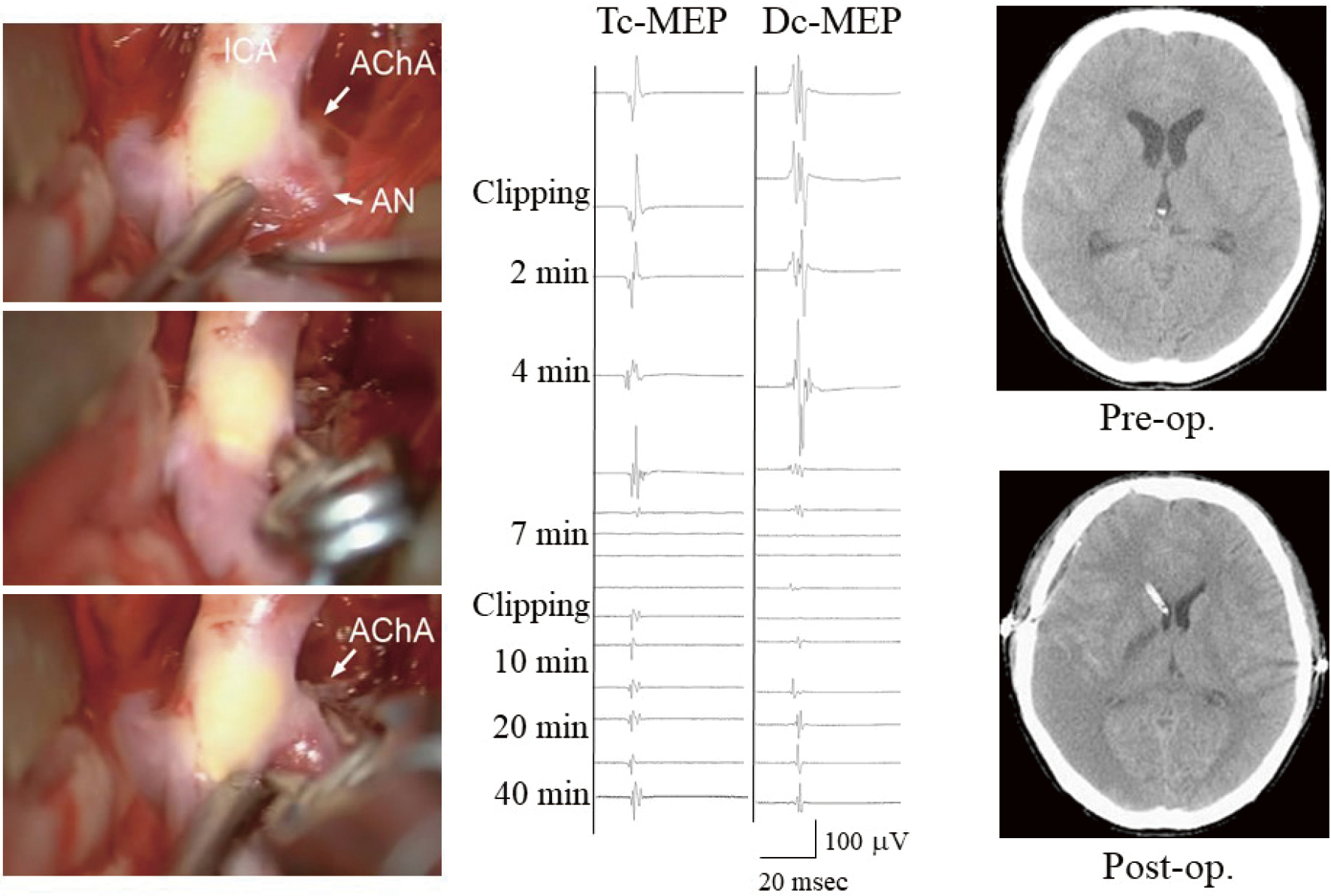- 著者
- Tatsuya SASAKI Kensuke MURAKAMI Atsushi SAITO Shinya HARYU Masayuki KAMEYAMA Yoshiharu TAKAHASHI Satoru TAKAMURO Nana KATO Toshiki ENDO
- 出版者
- The Japan Neurosurgical Society
- 雑誌
- Neurologia medico-chirurgica (ISSN:04708105)
- 巻号頁・発行日
- pp.2023-0007, (Released:2023-06-28)
- 参考文献数
- 24
The usefulness of transcranial motor evoked potentials (Tc-MEPs) in clipping surgery has been reported. However, numerous false positive and false negative cases were reported. We report the usefulness of a new protocol compared with direct cortical MEP (Dc-MEP).Materials were 351 patients who underwent aneurysmal clipping under simultaneous monitoring of Tc- and Dc-MEPs. A total of 337 patients without hemiparesis and 14 with hemiparesis were separately analyzed. Intraoperative changes of Tc-MEP thresholds were examined in the first 50 patients without hemiparesis. The stimulation strength of Tc-MEP was set at +20% of the stimulation threshold. As thresholds changed intraoperatively, thresholds were examined every 10 min and changed stimulation strength.Stimulation thresholds of Tc-MEP were significantly decreased after craniotomy and significantly increased after CSF aspiration. The recording ratios of Tc- and Dc-MEPs were 98.8% and 90.5%, respectively. Out of 304 patients without MEP change, 5 patients developed transient or mild hemiparesis with infarction of the territory of the perforating artery arising from the posterior communicating artery. Out of 31 patients whose MEP transiently disappeared, 3 patients developed transient or mild hemiparesis. The other two patients without MEP recovery manifested persistent hemiparesis. In 14 patients with preoperative hemiparesis, 3 patients whose healthy/affected ratio of Tc-MEP was large developed severe persistent hemiparesis.We clarified the intraoperative changes of Tc-MEP thresholds for the first time. A new protocol of Tc-MEP that followed thresholds and changed stimulation strength to +20% of thresholds is useful for stable monitoring. The usefulness of Tc-MEP is the same as that or better than that of Dc-MEP.
1 0 0 0 OA A Study of the Food Cycle of Growing, Arranging, Savoring, and Disposing in a Campus Setting
- 著者
- Toshiki Endo Shoko Chihara Akiyo Ishikawa Takako Narita
- 出版者
- Jiyu Gakuen College
- 雑誌
- Bulletin of Jiyu Gakuen College of Liberal Arts (ISSN:21896933)
- 巻号頁・発行日
- vol.3, no.1, pp.59-68, 2017 (Released:2017-12-21)
- 参考文献数
- 15
After the establishment of the Basic Law on Food Education (2005), one of the main tenets of school education in Japan has been to nurture individuals to lead a healthy dietary life, through the promotion of dietary education as a foundation for learning about nutrition and a healthy lifestyle in children. Moreover, the handbook on food guidance (2007) stipulates that food education should be incorporated into all aspects of school education. Accordingly, food education, which until then had been taught mainly through in "Home Economics", is now being recognized as a topic to be considered in every conceivable situation. This paper reports on the comprehensive and structured practical education of “food” at Jiyu Gakuen, wherein students from preschool to college each tend a plot of land for farming, and high school students take turns daily to prepare lunch for 300 students, including their own, and participate in the cleaning up after each meal. The environment for "food education" at Jiyu Gakuen is its nature-rich campus. In fields within the campus, students plow the land, sow the seeds, and grow food with utmost care. The food from nature’s bounty is processed and cooked, and enjoyed with gratitude in their meals at the dining table among peers. Students learn about the complete practical process as remnants after each meal are carefully collected and recycled back into the soil. Students realize that human life is sustained by plant and animal life, through their learning of this cycle of growing (farming), arranging (cooking), savoring (eating), and disposing (discarding). The students also learn about maintaining a healthy dietary life through realization of the importance of food as they engage in the process of growing and sacrificing plants and animals for food.
